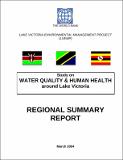| dc.description.abstract | Much has been achieved during LVEMP1 in terms of the countries’ understanding of the Lake
Victoria ecosystem, but still there is a limited knowledge of the water quality in various parts
(particularly bays) of the Lake and its relationship with human health in the area. The direct or
indirect measures for improving the livelihood of the inhabitants living in the Lake Region are
key goals of LVEMP2 and beyond. It was therefore important to get an overview of what is
known about the relationship water quality - human health, and “to review the relationship
between water quality and human health in the Lake region and the effects that various mitigation
measures may have. The Consultant decided to make the Study as practical as possible, because the findings should
hopefully lead to useful input for the planning of LVEMP2 activities to be more focused as
regards the study aspects. The Study was thus not meant to be a scientific research or theoretical
exercise, but rather trying to establish the water quality/human health relationship based on
available data on which aspects seem to have the largest impact. The Study had a dual approach:
a quantitative one (statistics and data for the last five years) and a qualitative one (interviews with
stakeholders, field observations, etc.), focussing on the following waterborne/-related diseases:
diarrhoea, dysentery, typhoid, cholera, schistosomiasis (bilharzia), intestinal worms and skin
infections. The water quality data from the lake largely came from LVEMP1 analysis, with
relatively good data basis in Tanzania. In Kenya, however, such data were scanted and in Uganda
virtually non-existent from the study areas. | en_US |

